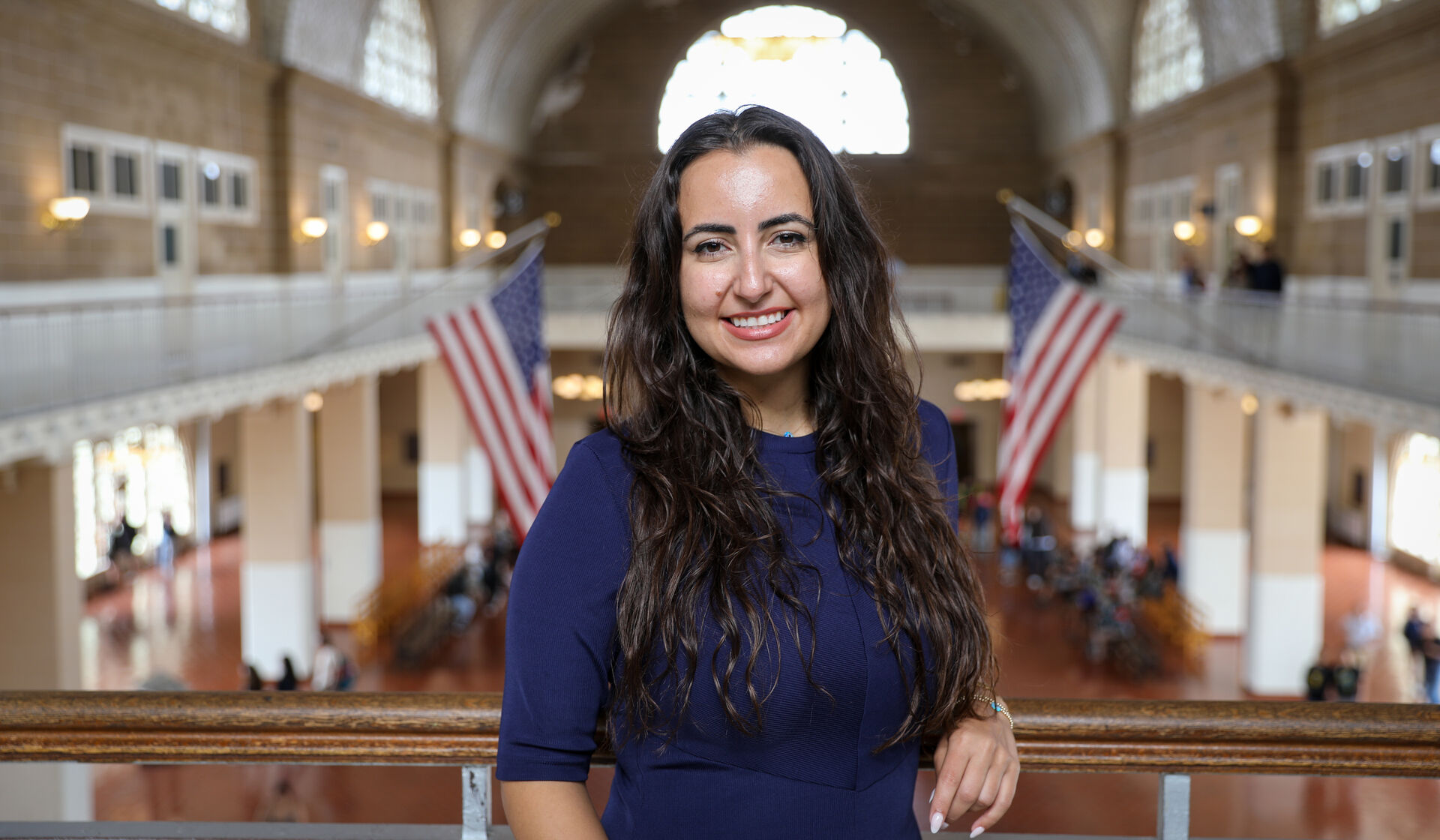The Mary H. Weiser Food Allergy Center at U-M provides cutting-edge care and research into a life-threatening ailment that affects one in every 13 children in the U.S.
Reese Miller’s dream is to be able to sink her teeth into a scoop of mint chocolate chip ice cream in a waffle cone. But for this 11-year-old, that dream is an unlikely reality. Reese has never had ice cream, having broken out in hives following her first taste of formula at just 5-months-old. As a toddler, a spoonful of egg sent her to the emergency room with labored breathing. Beef was later added to the list of food items that are off limits.
Yet, mistakes still occur.
A few years ago, after biting into what Reese thought was a plain turkey sandwich at a restaurant, she had an immediate reaction. Buried between the layers of bread and meat was an unexpected slice of cheese. “Sometimes it’s really scary when it’s really bad,” Reese says.
For her mother, Inge, every meal is a production; every children’s sleepover party can pose a potential hazard. When Reese attended a fourth grade camp one year ago, “I knew I needed to go with her,” Inge explains, not just to manage her food, but to make her daughter feel safe.
Reese is one of the fortunate cases. So far, the majority of her reactions have been managed by a dose of the antihistamine Benadryl, and always by her side is an EpiPen— an epinephrine auto injector of adrenalin that injects into the outer thigh. Still, given the rapid escalation in the number of children developing food allergies (see the sidebar on page 42), Inge feels increasingly frustrated that there is no permanent cure for her daughter’s ailment.
Thankfully, so do the many people working at the Mary H. Weiser Food Allergy Center, formerly the U-M Food Allergy Center, which was renamed in May 2015 to honor Mary Weiser’s advocacy. The center’s existence can be traced to the generosity of the Weiser family. Former U.S. Ambassador Ronald Weiser, ’66, and his wife, Eileen, ’75, gave $9.5 million to the center, while their son, Marc, ’95, and his wife, Mary, gave another $500,000.
The center’s function is to offer comprehensive clinical services to food allergy sufferers and their families, and to conduct cutting- edge research into the underlying abnormal immune responses that cause allergies. Currently, most therapies for food allergies only control the symptoms after an allergic reaction occurs. Researchers at the center are working to develop therapeutics that fundamentally alter the food allergic response.
Like Inge Miller, ’96, Mary and Marc Weiser know all too well what it is like to worry constantly about their child’s diet. Although in their case, they have not one, but two children suffering from food allergies.
It has now been more than a decade since their 1-year-old daughter, Cate, suddenly slumped into her high chair and began vomiting mere moments after taking a bite of scrambled egg. Despite having no family history of allergies, Cate, now 12, is severely allergic to peanuts, tree nuts, fish, dairy, and eggs. The fish allergy was discovered during a trip after Cate ingested a piece “half the size of my pinky nail,” recalls Mary. Cate had an immediate anaphylactic reaction in the woods of northern Michigan. Her parents rushed her to the hospital and arrived just in time to save her life. Her 9-year-old brother, Leland also has multiple allergies—in his case, to peanuts, tree nuts, and eggs.
“If somebody had told me back then that today AIDS would be a treatable disease and food allergies would not, I don’t think I would have believed them.” — James Baker Jr.
“You are constantly thinking about it. Holidays, birthdays, and field trips are fun for other people. For us, it is always a concern,” says Mary, whose fundraising efforts and advocacy have raised a further $20 million in donations for the center, beyond her family’s gift.
Mary hopes the center will improve diagnoses and become a global resource for public information. She also hopes it will attract leaders in the field. “Until we start funding this, the needle is never going to move,” she says. “The more brilliant minds working on it, the better off the whole food allergic community will be.”
One of the most difficult aspects of James Baker Jr.’s job is writing condolence notes to the families of children who have died from food allergies. Baker, the founding director of the center and CEO of the nonprofit organization Food Allergy Research & Education (FARE), uses an old-fashioned fountain pen and Crane stationery. He writes them, “Every day, we’re hoping to try and keep this from happening.”
Baker knows all too well what it is like to lose patients. As the immunology director of the Walter Reed National Military Medical Center in the AIDS unit in the 1980s, he watched helplessly as the patients there died without any effective treatment. “If somebody had told me back then that today AIDS would be a treatable disease and food allergies would not, I don’t think I would have believed them,” he says.
To understand why the numbers of food allergy sufferers have increased over the years, Baker points to changes in the human immune system largely derived from a now-pristine environment. “Food is much cleaner. There’s no dirt in it. Everything’s sterile.”
Dirt in food, Baker explains, shapes one’s immune system in a way that helps prevent infection. Previously, if a child had an immature immune system that reacted to food, subsequent exposure to infections and dirt would help the child evolve to the point of no longer having a reaction. But if the child’s immune system is fundamentally different, and the child doesn’t have those environmental triggers, it’s not going to go away.
What’s more, young people play outside less these days. The result is limited exposure to sunlight, which produces vitamin D and helps bolster the immune system, according to Baker. Nut allergies, in particular, may also be on the rise because peanuts have become more processed; they are dry roasted instead of roasted in oil, which makes them more allergenic. Dry roasting creates a dust that can linger on the skin, sensitizing people, particularly those with eczema, to peanuts.
“So all these effects, both the ones that are internal to people and those in the environment, have really changed our immune systems within three generations. So we have an epidemic,” Baker says. When he started out as an allergist almost 35 years ago, food allergies were an anomaly. “Now, it’s 30 percent of our practice. It’s one of the most common medical problems in pediatric care.”
Food Allergies by the Numbers
The statistics tell a startling story about this epidemic, which affects millions of Americans.
- Every three minutes, a food allergy reaction sends someone to the emergency department – that is more than 200,000 emergency department visits per year.
- Researchers estimate that up to 15 million Americans have food allergies; 6 million of them are children.
- According to a 2013 study by the Centers for Disease Control and Prevention, food allergies among children increased approximately 50 percent between 1997 and 2011.
- The economic cost of children’s food allergies is nearly $25 billion a year.
- Children with food allergy are two to four times more likely than children without food allergy to have other related conditions, such as asthma and other allergies.
- Eight foods account for 90 percent of all reactions: milk, eggs, peanuts, tree nuts, soy, wheat, fish, and shellfish.Even trace amounts of a food allergen can cause a reaction.
Source: Food Allergy Research & Education
For the moment, the only way patients can safeguard against food allergy reactions is by avoiding food triggers and carrying the EpiPen. Research at the center is focused on finding breakthroughs that move beyond prevention and into treatment.
“The idea is that we’ll be able to give people drugs that alter their allergic response and prevent the reactions from happening,” Baker says. He cites two treatments that are showing some promise in clinical trials. The first involves oral immunotherapy, in which carefully screened patients are given gradually increasing amounts of peanut protein under clinical supervision. Another is a skin patch with peanut on it developed by DBV Technologies. The peanut is taken up through the skin and winds up in the immune system, which seems to reduce the reactivity to food.
Patients enrolled in clinical trials will be treated at a U-M clinic, says Baker. “I view this as a true University resource that I’m going to use to raise young faculty and to recruit great scientists.” The clinic will also participate in the nationwide FARE Clinical Network that will work at improving food allergy care.
“There were no places even in many major cities where people could be treated for food allergies,” Baker explains.
Currently, most therapies for food allergies only control the symptoms after an allergic reaction occurs. Researchers at the center are working to develop therapeutics that fundamentally alter the food allergic response.
In June 2015, FARE announced its funding of more than $2 million for the initiative, a collaboration of 24 centers nationwide set up to accelerate the development of drugs to treat food allergies and improve patient care. The centers will test food allergy drugs using consistent protocols. The initiative also allows for access to a large pool of people to participate in clinical research trials. The largest controlled clinical trial on food allergies in the past has been 120 people. But in order to get a drug approved, Baker says the Food and Drug Administration recommends 1,000 patients per study.
“Doing human studies is crucial to understanding this important medical problem, and for the first time we have adequate facilities to conduct this work. I’m praying for the time when we can take the most seriously involved children and make them safe,” Baker says.
Inge Miller and her husband, David Miller, ’95, MDRES’05, MPH’05, an assistant professor in the Department of Urology at U-M who serves on the center’s advisory committee, said they would most likely be willing to have daughter Reese participate in the trials.
Mary Jane Marchisotto, FARE’s senior vice president of research, notes that funding remains crucial. In spite of an increase in the amount of federal funding for food allergy research (which has increased from $4 million in 2004 to $36 million in 2013), it is quite small in relation to the size of the affected population.
As for Baker, the memories of those lost to food allergies drives his desire to find treatments. He hopes for inroads that will eliminate one of his most challenging job duties: “I’d like to not write any more ‘I’m sorry’ notes.”
FARE Education Network Quiz
- One in 10 children with food allergies reports having been bullied, teased, taunted, or harassed specifically because of a food allergy. True or False?
- Home-baked goods are safe as long as the parent shows the teacher that the ingredient list is safe for students with food allergies. True or False?
- Hand sanitizers are not effective in removing food allergens. True or False?
- You should administer a second dose of epinephrine if symptoms have not subsided in five to 10 minutes. True or False?
- Hives or skin redness will always occur in cases of anaphylaxis. True or False?
ANSWERS: 1) False. About one-third of children report that they have been bullied because of their food allergy. 2) False. Schools should caution against home-baked goods because they are at a higher risk for cross-contact. 3 ) True. 4) True. 5) False. Students experiencing an allergic reaction may experience no skin symptoms. Hives do not occur in many cases of anaphylaxis.
Source:Food Allergy Research & Education
Julie Halpert, ’84, is a freelance journalist for publications including The New York Times, Newsweek, and The Wall Street Journal. She also blogs for The Huffington Post and teaches journalism in U-M’s Program in the Environment.
For more information, visit www.uofmfoodallergy.org





